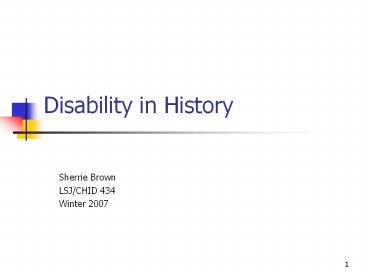Disability%20in%20History - PowerPoint PPT Presentation
Title:
Disability%20in%20History
Description:
Early Historical Interpretation of Physical/Mental Differences ... from implementing seclusion, corporal punishment, medical experimentation and ... – PowerPoint PPT presentation
Number of Views:23
Avg rating:3.0/5.0
Title: Disability%20in%20History
1
Disability in History
- Sherrie Brown
- LSJ/CHID 434
- Winter 2007
2
Topics
- Early Historical Interpretation of
Physical/Mental Differences - Experience of Disabled Persons in Nazi Germany
- Rise of Institutions in USA
3
One Approach
- How does history describe/explain/handle
variations of the human condition? - How are differences distinguishedi.e., what
difference rises to level of disability or
otherwise be considered negatively? - How is the difference explained?
- What value is placed on that difference?
- How is that difference treated/handled?
- Framework described by University of Maine
disability studies scholars on line at
http//www.ccids.umaine.edu/hrsaltc/history
4
Ancient Greece
- Distinguish
- Deformed infant
- Blind, Deaf, Lame
- Blind, Deaf, Lame
- Mental Illness
- What value is placed on that difference?
- Not human
- Immoral
- Well respected
- Well respected
- Explain the Difference?
- None
- Caused by gods for sinful acts
- War injury
- Supernatural
- How is that difference treated/handled?
- Left to die
- Ostracized
- Given special care and pension
- Participated in community life
5
Medieval Period
- Distinguish
- Behaved, comm. differently
- Atypical appearance/activity
- Cognitively different (MR)
- What value is placed on that difference?
- Evil or demonic
- Evil or demonic
- Divine
- Explain the Difference?
- Spiritual
- Sent to teach charity/tolerance
- Spiritual
- How is that difference treated/handled?
- Persecuted
- Cared for by clergy
- Participated in community
6
Enlightenment
- Distinguish
- Failure to thrive at birth
- Atypical activity/appearance
- Atypical behavior (MI)
- What value is placed on that difference?
- Not Human
- Part of human nature
- Unworthy
- Explain the Difference?
- None
- Injury, aging or illness
- Biological
- How is that difference treated/handled?
- No care
- No explanations for most but medical explanations
for those who could afford MD - Institution
7
Victorian Period (idea of normal)
- Distinguish
- Atypical behavior (cognitively impaired, MI or
socially deviant) - Deviant
- Inability to earn
- What value is placed on that difference?
- Unworthy
- Unworthy
- Reprehensible
- Explain the Difference?
- Poor or immoral
- Race, ethnicity, gender
- Immoral
- How is that difference treated/handled?
- Harsh institutional care
- Ostracized, institutionalized
- Ostracized, institutionalized
8
Early 20th Century
- Distinguish
- Physically/cognitively different
- Physically/cognitively different
- What value is placed on that difference?
- Less than human
- Well respected
- Explain the Difference?
- Bad genes
- War injuries/industrial accidents
- How is that difference treated/handled?
- Harsh institutional care/eugenics
- Financial/medical supportrehabilitation
9
Nazi Germany
- Distinguish
- Physically/cognitively different
- Physically/cognitively different
- What value is placed on that difference?
- Less than human
- Well respected
- Explain the Difference?
- Bad genes
- War injuries/industrial accidents
- How is that difference treated/handled?
- Genocide/medical experimentation
- Financial/medical supportrehabilitation
10
Rise of Institutions in USA
- First institution devoted exclusively to mental
disabilities established in 1773. - Mental disorders considered problem of
containment, not treatment. - Decades before Civil War characterized by belief
that institutions could cure lunatics and train
idiots. - States assume responsibilities for asylums and
enacted civil commitment laws to authorize
institutionalization.
11
Asylums become Institutions
- No cure found for most individuals and asylums
full of people labeled incurable. - They became more custodialgoal was to 1) keep
society safe from unpredictable violence and 2)
quarantine people who could spread the madness. - Dumping grounds for social undesirablesmany
prostitutes, immigrants, poor, incorrigible
wives, etc. - Institutionalization and forced sterilization
became the policy after Buck v. Bell Supreme
Court decision in 1927.
12
Willowbrook State School
- State supported institution for children with
mental retardation on Staten Island, NYC. - Plans developed in 1938, construction completed
in 1942 but run as army hospital until 1947. - In mid 1970s, home to 5,000 individuals.
- 1972 documentary expose by Geraldo Rivera on ABC
TV, NY affiliate.
13
NY State Association for Retarded Children v.
Carey (consent decree 1975)
- People with mental retardation have a
constitutional right to protection from harm. - Willowbrook forbidden from implementing
seclusion, corporal punishment, medical
experimentation and routine use of restraints. - Settlement mandates individual plans for
education, therapy, care and development of each
child. - Established a Consumer Advisory Committee of
parents, community leaders, residents (current
and former) to monitor.
14
Discussion
- How are Coastal Center and Willowbrook different?
How are they similar? - The nondisabled world sees powerlessness as the
natural product of dependence and dependence as
the natural product of our needs. - What is the governments responsibilityif
anyfor individuals like Harriet McBryde Johnson
or Bernard Carabello?































